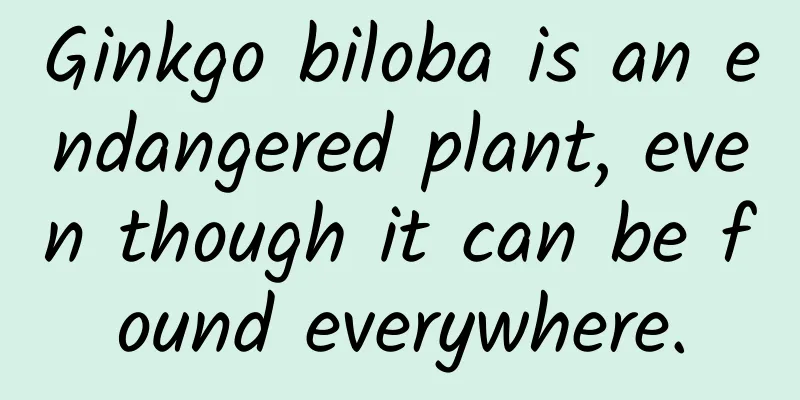Ginkgo biloba is an endangered plant, even though it can be found everywhere.

|
Review expert: Liu Xiaolu, Senior Engineer, Urban Construction (Beijing) Landscape Planning and Design Institute Co., Ltd. In quiet parks, in thousand-year-old temples, and on both sides of busy roads, several ginkgo trees are closely adjacent to each other. Their leaves are uniquely shaped, like delicate little fans, swaying in the breeze, adding a touch of coolness to the hot summer days. Image source: Qianku.com Ginkgo is often seen in our daily life. But do you know that this seemingly common tree is actually an endangered plant? If ginkgo becomes extinct, an entire plant class will disappear from the earth... 0 1 Living fossils in the plant world From a biological perspective, endangered refers to the survival status of plants in the wild environment, not including those artificially cultivated plants in your street or community. Therefore, the ginkgo we are talking about refers to "wild ginkgo". Image source: Science Popularization China Ginkgo is native to China. It is a relict species (i.e. a unique species or relict species from an ancient geological period) preserved after the Quaternary glaciation. It has undergone a long evolutionary history since its origin in the late Paleozoic Era and is known as the "living fossil" of the plant kingdom. The earliest fossils of Ginkgo can be traced back to 270 million years ago. According to fossil evidence, there were five families in the Ginkgoales, which were widely distributed on all continents of the world. When angiosperms rose rapidly in the Cretaceous period, Ginkgo also declined rapidly like other gymnosperms; after the Late Cretaceous period, Ginkgo plants other than Ginkgoaceae were basically extinct. Since the middle Pleistocene (580,000 to 140,000 years ago), the ginkgo has retreated again and again after experiencing multiple ice ages. Today, there are only three wild populations in eastern China (represented by Tianmu Mountain in Zhejiang), southwestern China (represented by Wuchuan in Guizhou and Jinfo Mountain in Chongqing), and southern China (represented by Nanxiong in Guangdong and Xing'an in Guangxi). 0 2 Are all existing ginkgo trees the same? Since most wild ginkgo populations are not in nature reserves, and ecological damage and human transplantation pose a serious threat to ginkgo, there have been no young trees naturally regenerated around many wild ginkgo trees for 10 years. In addition, most ginkgo trees used as urban street trees are "inbred", which cannot increase the genetic diversity of ginkgo. Today, ginkgo has really become a "lone hero" in the plant world. Therefore, the genes of ginkgo trees that can be seen everywhere in the streets and alleys are actually the same or similar. Image source: Qianku.com The existing ginkgo is the only remaining plant of the "Ginkgo class, Ginkgoales, Ginkgoaceae, Ginkgo genus, Ginkgo species". If ginkgo becomes extinct, the entire class will be extinct. Moreover, since the genes of currently cultivated ginkgo trees are no longer diverse, once a disease breaks out in nature that targets ginkgo, all ginkgo trees may die from viral infection. 0 3 The threat level is higher than that of the giant panda. Academician Zhou Zhiyan, a famous paleontologist, once said: "Ginkgo has actually entered a period of evolutionary decline. The decline of Ginkgo species and the reduction of wild distribution areas also indicate the decline of natural populations of Ginkgo." In 1999, Ginkgo was designated as a national key protected wild plant (first level). What is the concept of "national first-class key protected wild plants"? The giant pandas "Hua Hua" and "Fu Bao" that everyone loves are national first-class key protected animals. By analogy, you can understand how rare ginkgo is. Image source: IPANDA Among the species with extinction risk assessed by the International Union for Conservation of Nature (IUCN), the threat level of ginkgo is even higher than that of giant panda. In 2021, due to the effective improvement of wildlife habitats, the threat level of giant pandas was downgraded from Endangered (EN) to Vulnerable (VU): Image source: Screenshot from IUCN official website But currently Ginkgo is still in the endangered (EN) category: Image source: Screenshot from IUCN official website We look forward to hearing the good news about Ginkgo's "downgrading". 0 4 Every blade of grass and every tree is precious Ginkgo has witnessed the changes of the Earth for hundreds of millions of years. Its endangerment is not only a tragedy for a species, but also a loss for the entire ecosystem. It's not just the ginkgo, many other species are in danger. It's no exaggeration to say that biodiversity is facing serious threats. By the end of 2023, there were 157,190 species listed in the Red List of Threatened Species of the World Conservation Union (IUCN), of which 44,016 were on the verge of extinction. Today, humans have begun to pay attention to the survival status of these species. We believe that with our joint efforts, they can survive the crisis of extinction and continue to write the legend of life. |
<<: Are stars necessarily heavier than planets? This "forbidden" planet breaks the stereotype!
>>: Fast for two days a week, is the 5:2 fasting method the “savior” for “fatty liver”?
Recommend
Down jackets can’t be machine washed, and they can’t be dry cleaned either?
Audit expert: Zhu Guangsi Member of Beijing Scien...
Dingxiang Doctor Product Analysis
I have been suffering from insomnia recently, and...
How to increase App users by not filling in invitation codes
What should we do when fission marketing becomes ...
How to write the New Year copy for 2018?
It’s the end of the year, and everyone is startin...
How to buy the gold and silver commemorative coins for the 600th anniversary of the completion of the Forbidden City? Purchase channels are as follows
How to buy the gold and silver commemorative coin...
Those who only look at the CTR of information flow ads are all hooligans! Attached effect case
Most of the articles on the market about informat...
As virtual reality movies come under fire, it's time to think about something other than the technology
The new Sundance Film Festival was held in Park C...
Why is there always the sound of marbles falling to the floor upstairs in the middle of the night?
I don't know if you have ever encountered suc...
A-share quantitative investment course that novices can understand - Quantitative Godfather Ding Peng
A-share quantitative investment course that novic...
Squirrels can't speak bird language, so how come they are so interested in listening to the birds chatting next door?
Nature is not a very friendly place for small ani...
Holistic thinking on operational product technology, you deserve it!
When a product is in its early stages, the produc...
How to use public account data? It is enough to analyze these 4 points!
The WeChat public account backend contains detail...
Frozen for ten months without rotting! What is the "technology and hard work" of this kind of lychee?
Science Times reporter Hu Lijuan "If I can e...
Without it, our life will be difficult!
On July 8, 1986, my country's domestic satell...









